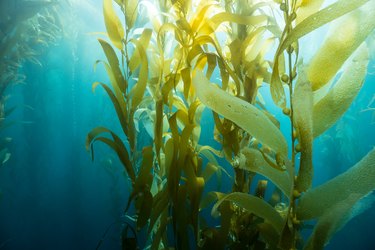
Contrary to what we may believe, seaweed is not a plant. It may look like one, but plants have roots, and seaweed does not. Seaweed is an algae, which is why other names for seaweed include "sea algae." Seaweed grows in oceans, lakes and rivers. It is estimated that there are between 30,000 and 1 million sea algae types. Unlike the single-celled algae we learned about in school, seaweed is multicellular, or "big algae," where the cells have bonded together to form a treelike structure.
Plants in the Ocean Don’t Survive
Video of the Day
Plants need air and sun, and they develop roots. Seaweed simply needs to anchor itself to a solid surface under the water, where it begins its growth toward the sun. That anchor is known as a holdfast, and it can be either a rock or the bottom of the sea. It absorbs nutrients from the water and can grow hundreds of feet tall.
Video of the Day
Plants cannot grow in salt water. The water drowns the roots of plants, and the salt poisons the plant's system. Since seaweed isn't a plant, it can't get waterlogged. Its thick stems protect it from the corrosive salt water. Some have even developed bladders that allow it to float. All the substances seaweed needs to survive are dissolved in the sea water; therefore, seaweed doesn't need roots to grow. In warm climates when it is adjacent to a growing field, the nitrogen-enriched soil penetrates the water, and the seaweed, infused with the nitrogen, overtakes the water surface.
Three Sea Algae Types
Seaweed comes in three colors, and each color suits a purpose. Green seaweed grows up to 3 feet tall and serves as a hideaway for sea creatures who not only hide in it but eat the seaweed as well. It grows in shallow water.
Red algae is purposed for human industry and is used in vegetable gelatin and cosmetics. It grows at the greatest depth, sometimes as deep as 90 feet. Brown algae, which includes the kelp family, is the largest of the seaweed types and provides the right environment for marine life that can't exist elsewhere. It grows up to 20 inches a day and is used in fertilizers, medicines and dietary substances. It survives somewhere between the shallow and deep water.
Nutrition, light and temperature dictate the depths at which the different-colored algae grow. Seaweed has evolved to take advantage of the growth strategies available and adapts in order to grow.
Benefits of Seaweed
The ecological benefits of seaweed are enormous. It produces 90 percent of the oxygen in the atmosphere, and 80 percent of the organic matter on Earth comes from seaweed. Terrestrial plants produce only 1 to 2 percent. The mineral content is 10 times greater than plants that have matured in soil. Seaweed is also low in calories. The fact that it grows in saltwater doesn't affect the low sodium content of seaweed.
The green skin in which sushi is wrapped is called nori, and it is seaweed. It is prominent in the Japanese diet, and the Japanese eat more nori than any other culture, leading nutritionists to relate the use of seaweed to the longevity of the Japanese.
The protective gel coating on seaweed keeps it from getting stuck to other algae. It protects the seaweed from sun damage as well as the sea creatures hiding within the fronds.